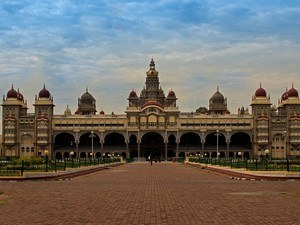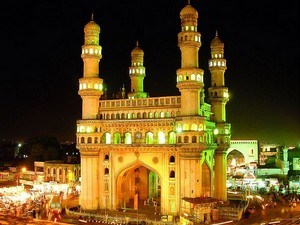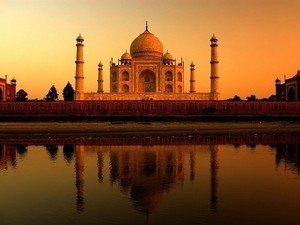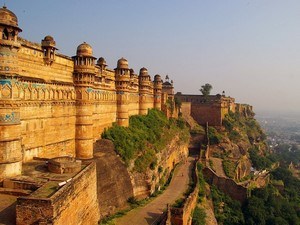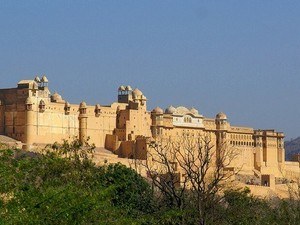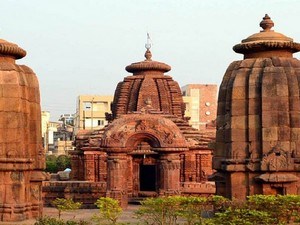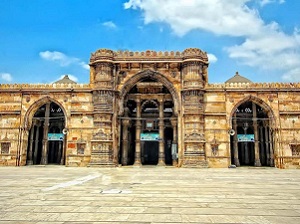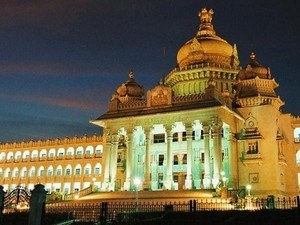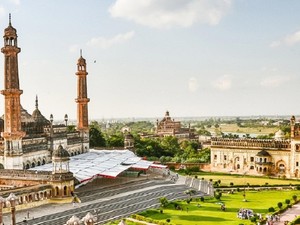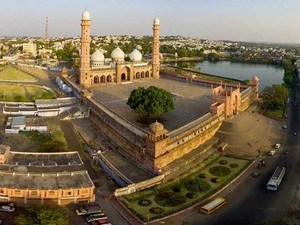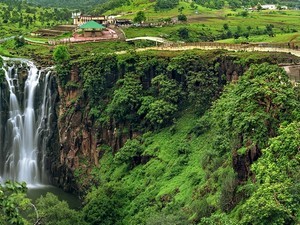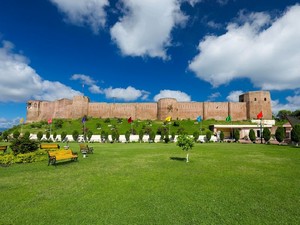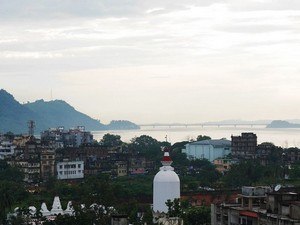1
DAY 1 : JANTAR MANTAR - RED FORT - AKSHARDHAM TEMPLE
DAY 1 : JANTAR MANTAR - RED FORT - AKSHARDHAM TEMPLE
 Travel from to
Travel from to
 Sightseeing
Sightseeing
Leisure / No Sightseeing
At a distance of 3 km from Delhi Junction Railway Station, Jantar Mantar is one of the best historical places in Delhi situated in Parliament Street near Connaught Place. Jantar Mantar was declared a national monument in 1948. The Jantar Mantar is among the best places to visit in Delhi and is a great place for astronomy lovers.
Jantar Mantar, also known as the Delhi Observatory was built in 1724 AD. It is one of five astronomical observatories in India that was designed by Maharaja Sawai Jai Singh II of Jaipur. The other four observatories are situated at Jaipur, Varanasi, Ujjain and Mathura. The essential purpose of the Jantar Mantar was to accumulate astronomical tables which in turn would help predict the time and movement of the celestial bodies such as the sun, moon and other planets. The task was given to Raja Jai Singh by the Mughal emperor Muhammad Shah.
It houses .....
 Duration of visit: 30 Mins - 1 Hr
Duration of visit: 30 Mins - 1 Hr
 Timings: 6 AM to 6 PM
Timings: 6 AM to 6 PM
At a distance of 4 km from New Delhi Railway Station and 2.5 Km from Jantar Mantar, Lakshmi Narayan Temple also known as the Birla Mandir is situated at Mandir Marg near Connaught Place in New Delhi. It is one of the first temples built by the Birlas in India and one of the major Delhi tourist attractions.
This temple was built by the famous industrialist and philanthropist, Baldeo Das Birla and his son Jugal Kishore Birla of Birla family. The construction of temple was started in 1933 and completed in 1939. The foundation stone of temple was laid by Maharaja Udaybhanu Singh. The temple was built under guidance of Pandit Vishwanath Shastri and the architect was Sri Chandra Chatterjee. Birla Mandir was inaugurated by Mahatma Gandhi in 1939. At that time, Mahatma Gandhi kept a condition that the temple should allow people from all the castes.
The temple is dedicated to Lord Vishnu and Goddess Lakshmi. The three storeyed temple was built in the Nagara style of Hindu temple architecture. .....
 Duration of visit: 1 Hour
Duration of visit: 1 Hour
 Timings: 4.30 AM - 1.30 PM and 2.30 PM - 9 PM
Timings: 4.30 AM - 1.30 PM and 2.30 PM - 9 PM
At a distance of 3.5 km from New Delhi Railway Station, Jama Masjid or Masjid-i-jahan-Numa is located in the center of old Delhi near the famous Red Fort. This is one of the largest mosques in India and one of the last monuments built by Mughal Emperor Shah Jahan. It is one of the top places to visit in Delhi city and also among the top historical sites in Delhi.
Jama Masjid was commissioned by Shah Jahan between 1644 and 1656 at a cost of 1 million rupees. This mosque was constructed with the efforts of more than 5,000 workers. The Masjid was completed under the supervision of Saadullah Khan, the Prime Minister of Shah Jahan and was inaugurated by an imam from Bukhara, present-day Uzbekistan. After the British victory in Revolt of 1857, they occupied the mosque and stationed their soldiers here.
The mosque has three large gates, four towers and two 40 m high minarets constructed using red sandstone and white marble. The mosque is built on a red sandstone porch, which is about .....
 Duration of visit: 1 Hour
Duration of visit: 1 Hour
 Timings: 7 AM to 12 PM and 1.30 PM t0 6.30 PM
Timings: 7 AM to 12 PM and 1.30 PM t0 6.30 PM
At a distance of 4 km from New Delhi Railway Station, The Red Fort or the Lal Qila is one of the best historical places in Delhi situated on the western bank of the River Yamuna. This grand fort is a UNESCO World Heritage Site in Delhi, from where the prime minister addresses the nation every year on Independence Day (15 August). It is located in the center of Delhi and houses a number of museums. It is one of the best places to visit in Delhi and also one of the top attractions you must include in Golden Triangle tour.
The Red Fort was built by Shah Jahan between 1638 and 1648. The Fort was built when Shah Jahan transferred his capital from Agra to Delhi. The fort is better planned than the Agra Fort and was the residence of the Mughal emperor of India for nearly 200 years, until 1857. It was originally called as Quila-i-Mubarak, meaning the blessed fort, as it was the royal .....
 Duration of visit: 2 Hours
Duration of visit: 2 Hours
 Timings: 6 AM to 6 PM on all days. Closed on Monday.
Timings: 6 AM to 6 PM on all days. Closed on Monday.
At a distance of 5 km from New Delhi Railway Station, Raj Ghat is a memorial dedicated to the Father of the Nation, Mahatma Gandhi located on the banks of Yamuna River in Old Delhi.
Raj Ghat is the last resting place of Mahatma Gandhi. The cremation of Mahatma Gandhi took place at the Raj Ghat on 31st January 1948, a day after his assassination. The memorial was designed by Vanu G. Bhuta, who intended it to reflect the simplicity of the Mahatma's life. It has won several awards for its architectural design.
The memorial stone of Mahatma Gandhi placed on a simple square platform made of black stone, with the words Hey Ram inscribed on it. It is left open to the sky while an eternal flame burns perpetually at one end. The road on which it is located is also known as the Mahatma Gandhi Road.
It is situated amidst a well maintained garden with fountains and numerous trees that give the area a serene atmosphere. Near the memorial, there are labeled trees planted by visiting .....
 Duration of visit: 30 Mins - 1 Hr
Duration of visit: 30 Mins - 1 Hr
 Timings: 5 AM to 7 PM
Timings: 5 AM to 7 PM
At a distance of 10 km from New Delhi Railway Station, Akshardham Temple or Swaminarayan Temple is located on the banks of River Yamuna near Nizamuddin Bridge in Delhi. The temple is included in the list of Seven Wonders of the 21st Century by the prestigious Reader's Digest magazine. It is one of best built temples in India and among must visit tourist places in Delhi. It also has been listed in the 2009 edition of the Guinness World Records book as the largest Hindu temple in the world.
Akshardham Temple is dedicated to Lord Swaminarayan. Akshardham means the adobe of the supreme lord and the temple is a fine example of the Hindu architecture. The complex is the second Akshardham complex in the country after the one at Gandhinagar in Gujarat.
The building was inspired and moderated by Pramukh Swami Maharaj who was the spiritual leader BAPS community. It was inaugurated in November 2005 by the President, Dr. APJ Abdul Kalam.
Spread over 100 acres, the temple complex is .....
 Duration of visit: 2 Hours
Duration of visit: 2 Hours
 Timings: 9.30 AM to 8 PM. Closed on Monday
Timings: 9.30 AM to 8 PM. Closed on Monday
2
DAY 2 : NATIONAL MUSEUM - MODERN ART GALLERY - HUMAYUN TOMB
%%Itinerary_Title_Day2%%
At a distance of 4.5 km from New Delhi Railway Station, India Gate is one of the most popular monuments situated at eastern end of Raj Path in New Delhi. It is also one of the most visited tourist places in Delhi.
India Gate, Originally called the All India War Memorial, is a war memorial in honour of the 70,000 Indian soldiers who died during the World War I. The memorial bears the names of more than 13,516 British and Indian soldiers killed in the Northwestern Frontier in the Afghan war of 1919.
It was designed by the famous British architect, Edward Lutyens and the foundation stone was laid down by the Duke of Connaught in 1921. The monument similar in design to the French war memorial, the Arc-de-Triomphe, was completed in 1931.The monument was dedicated to the nation in 1931 by the then Viceroy, Lord Irwin. Another memorial, Amar Jawan Jyoti was added much later, after India got its independence. The eternal flame burns day and night under the arch to remind the nation .....
 Duration of visit: 30 Mins
Duration of visit: 30 Mins
 Timings: 24 hours
Timings: 24 hours
At a distance of 4.5 km from New Delhi Railway Station, The National Museum is located on Janpath close to the road between India Gate and Rashtrapati Bhawan. This museum is managed by the Ministry of Culture and is one of the largest museums in India and among the famous Delhi tourist places.
The National Museum was established on 15th August 1949 and houses artifacts ranging from pre-historic to modern era. The blue-print of the National Museum had been prepared by the Gwyer Committee set up by the Government of India łn 1946.The museum functioned in the Rashtrapati Bhawan during its initial years. The present building was laid by Pandit Jawaharlal Nehru on 12th May, 1955 and it was formally opened to public on 18th December 1960.
There are around 200,000 beautiful artifacts of both Indian as well as international origin housed in the museum. Some of the artifacts are more than 5,000 years old. It has articles from pre-historic era to contemporary art works. One of the popular .....
 Duration of visit: 2 Hours
Duration of visit: 2 Hours
 Timings: 10 AM to 5 PM, closed on Mondays and public holidays
Timings: 10 AM to 5 PM, closed on Mondays and public holidays
At a distance of 5 km from New Delhi Railway Station, The National Gallery of Modern Art is one of the most celebrated art galleries in Delhi and is located in Jaipur House near the India Gate circle.
The National Gallery of Modern Art (NGMA) is the premier art gallery under Ministry of Culture, Government of India. The Gallery was formally inaugurated by Vice-president Dr S. Radhakrishnan in 1954. The royal building of the museum was formerly the residence of erstwhile Maharajas of Jaipur. Designed by Sir Arthur Bloomfield and built in 1936, the building is in butterfly shape with a central dome.
The National Gallery of Modern Arts appointed a renowned German Historian named Herman Goetz who had successfully set up the Baroda museum as the first curator of this Museum. The gallery is home to more than 14,000 works of art by artists such as Raja Ravi Verma, Nobel Laureate Rabindranath Tagore, Gaganendranath Tagore, Jamini Roy, Amrita Sher-Gill and Nandalal Bose, among others.
In .....
 Duration of visit: 1-2 Hours
Duration of visit: 1-2 Hours
 Timings: 10 AM to 5 PM. Closed on Mondays and public holidays
Timings: 10 AM to 5 PM. Closed on Mondays and public holidays
At a distance of 7.5 km from New Delhi Railway Station and 7 km from Hazrat Nizamuddin Station, Safdarjung Tomb is located near the Safdarjung Airport at the T-junction of Lodi Road and Aurobindo Marg. It is located at a distance of 1 km from the Lodi Garden. It was declared as a UNESCO World Heritage site in 1993.
Safdarjung Tomb was built by his son Shujaud Daula in 1754. It is among the best tourist places in Delhi and also among the top historical places in Delhi city. This Tomb is dedicated to Mirza Muqeem Abdul-Mansur Khan, who was also known as Safdarjung. He was the viceroy of Oudh under Muhammad Shah and prime minister under Ahmad Shah. The tomb is the last example of the pattern which began with Humayun's tomb.
The Tomb was built in distinct Mughal architecture. Constructed in the center of a large garden, the compound is decorated with ponds and fountains. Crafted out of red sandstone with a white marble dome, the Tomb is built on a raised platform. The tomb has .....
 Duration of visit: 30 Mins
Duration of visit: 30 Mins
 Timings: 6 AM to 6 PM
Timings: 6 AM to 6 PM
At a distance of 6.5 km from New Delhi Railway Station and 5 km from Hazrat Nizamuddin Station, Lodi Garden is located at Lodi Road. This protected complex encloses several historical monuments including tombs, mosques and a bridge, belonging to the Lodi and Sayyid dynasties. It is one of the popular places to visit in Delhi city.
The beautiful Lodi Garden was built by two Delhi Sultanate dynasties, the Sayyids and Lodis in the 15 and 16th centuries. It was landscaped in 1936 by Lady Willington, wife of Marquees of Willington, Governor-General of India during the British rule. The original name of Lodhi Garden was Lady Willington Park which later renamed as Lodi Garden after Indian Independence in 1947.
Lodi Garden has a huge park with wide lawns, trees, plants and flowers, set against a backdrop of beautiful monuments. Spread over 90 acres, it contains Mohammed Shah's Tomb, Tomb of Sikandar Lodi, Shisha Gumbad and Bara Gumbad.
The tomb of Mohammed Shah, the last ruler .....
 Duration of visit: 1 Hour
Duration of visit: 1 Hour
 Timings: 6 AM to 7 PM
Timings: 6 AM to 7 PM
At a distance of 8 km from New Delhi Railway Station and 3 km from Hazrat Nizamuddin Station, Humayun's Tomb is one of the prime tourist places to visit in Delhi and one of the top historical places in Delhi city. The tomb is an UNESCO World Heritage Site. It is the final resting place of Humayun, the second Mughal Emperor and father of Akbar.
The construction of this tomb was commissioned by Humayun's wife, Hamida Banu Begum or Haji Begum in 1562. It was designed by Mirak Mirza Ghiyath, a Persian architect. Humayun's tomb was based on Gur-e Amir, the tomb of Mughal ancestor Timur in Samarkand. The tomb was completed in 1572 AD and is believed to have costed 15 lakh rupees at the time of its completion. The entire structure is built using red sandstone.
Humayun's tomb is a fine specimen of the great Mughal architecture, which was inspired by Persian architecture. The tomb was the first garden-tomb on the Indian subcontinent. Its unique beauty is said to have inspired several .....
 Duration of visit: 1-2 Hours
Duration of visit: 1-2 Hours
 Timings: 6 AM to 6 PM
Timings: 6 AM to 6 PM
3
DAY 3 : QUTUB COMPLETE - MEHRAULI ARCHAEOLOGICAL PARK - LOTUS TEMPLE
%%Itinerary_Title_Day2%%
At a distance of 15 km from New Delhi Railway Station, Qutub Minar is the magnificent tower of victory stands in the Qutub Complex located at Aurabindo Marg near Mehrauli in Delhi. Qutub is the highest tower in India and is an UNESCO World Heritage Site. It is among the must visit Delhi tourist places and one of the best heritage sites in Delhi city. It is also commonly featured in the promotion of Delhi Tourism.
Qutub-ud-Din Aibak laid the foundation of Minar in 1199 AD for the use of the Mu'zzin (crier) to give calls for prayer and raised the first storey, to which three more storeys were added by his successor and son-in-law, Shamsud-Din Iltutmish (AD 1211-36). Numerous inscriptions in Arabic and Nagari characters in different places of the Minar reveal the history of Delhi. According to the inscriptions on its surface it was repaired by Firoz Shah Tughlaq (AD 1351-88) and Sikandar Lodi (AD 1489-1517). Major R. Smith also repaired and restored the Minar in 1829.
It is an .....
 Duration of visit: 1 Hour
Duration of visit: 1 Hour
 Timings: 6.30 AM to 6.30 PM
Timings: 6.30 AM to 6.30 PM
At a distance of 15 km from New Delhi Railway Station, Alai Minar is an incomplete monument stands just north of Qutub Minar in the Qutub Complex.
The Alai Minar is a massive structure which was started by Aladdin Khilji in 1311 AD. Sultan Aladdin Khilji, an over ambitious Sultan of the Khilji dynasty, wanted to build a structure that would be double the height of Qutub Minar to commemorate his victory over one of his Deccan campaigns. He also executed the plan and increased the size of the enclosures of the Quwwat-Ul-Islam Masjid by four times its original size to provide a ceremonial entrance gateway on either sides of the mosque. He wanted the Alai Minar to match up with the size of the increased height of the mosque and also wanted a second tower of victory under his name and hence the Alai Minar was initiated.
The construction was completed up to the first storey but unfortunately, the construction was abandoned after the death of Sultan Ala-ud-din Khalji in 1316 AD and .....
 Duration of visit: 15 Mins
Duration of visit: 15 Mins
 Timings: Qutub Complex Timings
Timings: Qutub Complex Timings
At a distance of 15 km from New Delhi Railway Station, Alai Darwaza is a magnificent gateway situated north of Qutub Minar in the Qutub Complex.
The Alai Darwaza was built by Aladdin Khilji in 1311 AD with exquisite inlaid marble decorations and latticed stone panels. The Alai Darwaza was a part of Aladdin Khilji's extension of the Quwwat-ul-Islam mosque. It was one of the four grand gateways built by the Sultan; the other three could not be completed because of the death of Ala-ud-din in AD 1316.
This is the main gateway from southern side of the Mosque. It highlights the remarkable skills of Turkish and local artisans who worked on it. It is considered to be one of the most important buildings built during Delhi Sultanate period. Alai Darwaza is follows the traditional Islamic architectural style. It was built using red sandstone while white marble was used on the exterior walls.
Square in plan and with a large dome on top, Alai Darwaza follows principles of symmetrical .....
 Duration of visit: 15 Mins
Duration of visit: 15 Mins
 Timings: Qutub Complex Timings
Timings: Qutub Complex Timings
At a distance of 15 km from New Delhi Railway Station, Alauddin Khilji Tomb and Madrasa are situated in the Qutub Complex. It was the first structure in India with a tomb standing alongside a Madrasa.
Ala-ud-din's Madrasa is located to the south-west of the Quwwat-ul-Islam Mosque. It was established by Ala-ud-din Khilji, as a college for education on Islamic scriptures and theology. It consists of rooms and halls built around a quadrangular court. Screened walls were originally present on the eastern and western sides of the quadrangular court. On the western side, a group of seven small, cell-like structures are present, which are believed to have served as residents of the teachers and staff. The entry on the north side consists of an elaborately carved doorway.
The central room of the Madrasa, which has Aladdin tomb, has now lost its dome, though many rooms of the structure are intact. Alauddin Khilji was the second Sultan of Delhi from Khilji dynasty, who ruled from 1296 .....
 Duration of visit: 15 Mins
Duration of visit: 15 Mins
 Timings: Qutub Complex Timings
Timings: Qutub Complex Timings
At a distance of 15 km from New Delhi Railway Station, The Iron Pillar is standing at the center of the Quwwat-ul-Mosque in the Qutub Complex.
The Iron Pillar dates back to around 4th century, which was erected for honouring Lord Vishnu and in remembrance of Chandragupta II Vikramaditya (375-413). Based on inscriptions and archaeological evidence, the Iron Pillar of Delhi was originally located in Udayagiri near Vidisha in Madhya Pradesh. It was brought to its current location in 1233 AD by Shams-ud-din Iltutmish during his invasion of Malwa. It was erected as a flag pole and it is still a mystery that how this pillar moved to the present location in Qutub Minar. The pillar also highlights ancient India's achievements in metallurgy.
This pillar is about 7.3 m tall and is made of 98% wrought iron, which has not rusted or decomposed for more than 1600 years. The decorative bell at the top end of the Iron Pillar presents a marvelous design. The next part of the structure is the .....
 Duration of visit: 15 Mins
Duration of visit: 15 Mins
 Timings: Qutub Complex Timings
Timings: Qutub Complex Timings
At a distance of 15 km from New Delhi Railway Station, The Iron Pillar is standing at the center of the Quwwat-ul-Mosque in the Qutub Complex.
The Iron Pillar dates back to around 4th century, which was erected for honouring Lord Vishnu and in remembrance of Chandragupta II Vikramaditya (375-413). Based on inscriptions and archaeological evidence, the Iron Pillar of Delhi was originally located in Udayagiri near Vidisha in Madhya Pradesh. It was brought to its current location in 1233 AD by Shams-ud-din Iltutmish during his invasion of Malwa. It was erected as a flag pole and it is still a mystery that how this pillar moved to the present location in Qutub Minar. The pillar also highlights ancient India's achievements in metallurgy.
This pillar is about 7.3 m tall and is made of 98% wrought iron, which has not rusted or decomposed for more than 1600 years. The decorative bell at the top end of the Iron Pillar presents a marvelous design. The next part of the structure is the .....
 Duration of visit: 15 Mins
Duration of visit: 15 Mins
 Timings: Qutub Complex Timings
Timings: Qutub Complex Timings
At a distance of 17 km from New Delhi Railway Station, Mehrauli Archaeological Park is an archaeological area located close to Qutub Complex in Delhi. It is one of the popular historical sites in Delhi.
Spread over 200 acres in Mehrauli, Mehrauli Archaeological Park consists of more than 100 monuments with great historical significance. It is the only area in Delhi known for 1,000 years of continuous inhabitation and includes the ruins of Lal Kot built by Tomar Rajputs in 1060 AD. Thus it is the oldest fort of Delhi and comprises some historical structures like Tomb of Balban, Quli Khan's tomb, Jamali Kamali Mosque and Tomb, Rajon Ki Baoli and others.
Balban's Tomb is situated at the entrance which is one of the finest examples of the simple Indo-Islamic architecture. The Tomb of Ghiyas-ud din Balban was constructed in 1287 AD. Balban was the ruler of Delhi Sultanate from 1266 to 1287. It is believed to be the first building with arches built in India. This tomb is said to .....
 Duration of visit: 1-2 Hours
Duration of visit: 1-2 Hours
 Timings: 6 AM to 6 PM
Timings: 6 AM to 6 PM
At a distance of 15 km from New Delhi Railway Station 2.5 km from Okhla Railway Station, The Lotus Temple is located at Bahapur Hill. Also called Bahai Temple or the Bahai House of worship, the Lotus Temple is one of the major landmarks and among the most visited places of sightseeing in Delhi.
Lotus Temple was found by the believers of the Bahai Faith, an independent world religion, which was founded by Baha'ullah. This temple is an ideal place of meditation which is open to all other faiths. Lotus Temple is so named because of the lotus like structure of the temple. It is one of seven Bahai Houses of Worship in the world and is one of the most visited sites in the world with an average of three and a half million visitors each year.
The temple was designed by Fariborz Shaba, a Canadian architect of Iranian origin. He took 10 years in designing the structure. The construction of the building began in 1980 and was completed in 1986 at a cost of Rs. 10 million and was opened .....
 Duration of visit: 1-2 Hours
Duration of visit: 1-2 Hours
 Timings: 9 AM to 5.30 PM. Closed on Monday
Timings: 9 AM to 5.30 PM. Closed on Monday
End
 Travel from to
Travel from to
 Travel from to
Travel from to
END OF THE TOUR

